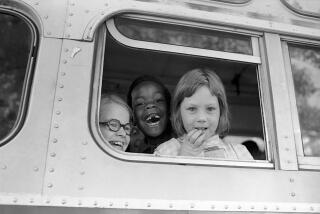BOOK REVIEW : The Subject of Gender in Public Education : LEARNING TOGETHER; A History of Coeducation in American Public Schools <i> by David Tyack and Elisabeth Hansot</i> Yale University Press $29.95, 369 pages
- Share via
In “Learning Together,” authors David Tyack and Elisabeth Hansot ask, “How do schools look when viewed through the lens of gender?”
In answering the question, they provide us not only with a valuable historical overview on how reformers have used the classroom as a panacea for social ills since 1642, but also a timely book for our present, fevered debate on the canon, ethnicity and racial politics of American education.
According to the authors, Colonial America slipped almost imperceptibly into the practice of educating girls and of employing women as teachers, for the school was an extension of the family and church, where sex segregation was eased by the 18th Century. “Parents were solicitous about the salvation of daughters as well as sons, and this required both girls and boys to read the Bible. In significant ways, the soul had no gender for the Puritans.”
The relative ease with which the Puritans accepted schooling for girls became a subject of debate shortly after the Revolution, then a bristling controversy over secondary education for females in the 19th Century, when high schools appeared and few boys wanted anything to do with them.
By the middle of the 19th Century, write the authors, “almost as many girls as boys were attending elementary public schools,” and this, they say, “was arguably the most important event in the gender history of American public education.”
Moreover, many post-Revolution reformers, such as Horace Mann, viewed women as natural teachers, insisting that “a man, superintending a nursery of children, is like an elephant brooding chickens.”
Although women were not deemed worthy of the vote, some 19th-Century educators saw them as “equals of men . . . but considered them nonetheless as physically, morally, and socially different . . . and destined to exercise their influence in different ways.”
One way was teaching, “a respectable and serviceable occupation, honored by high rhetoric,” though women were paid less than men and were expected at some point to leave the profession to marry and start a family. Nevertheless, the sexual stereotyping of the period made women preferable for elementary education. It was believed that a woman’s presence brought out chivalry in boys, and that through coeducation the sexes influenced each other in positive ways.
Yet this mid-century virtue became by the Progressive Era the very basis of arguments for gender separation.
As always, the problem was boys. On the whole, they performed less well, socially and scholastically, than their female counterparts--that is, when they even bothered to attend that amorphously defined institution called the high school. “Boys,” write the authors, “often regarded secondary education as irrelevant to their futures” because they could find jobs without going to high school. For girls, it was “a gateway . . . into teaching careers.”
If boys were failing to perform, some such critics of the schools as Adm. F. E. Chadwick were certain the problem was rooted not in the boys but in the coeducational institution itself--specifically in women teachers who were incapable of inspiring the “force of character” needed to make strong, vigorous males.
“Is there not something wrong with the high school boy,” wrote G. Stanley Hall, “who can truly be called a perfect gentleman, or whose conduct and character conform to the ideals of the average unmarried female teacher?”
The concern over poor male performance in high schools led directly in the early 1900s to adding gender-specific electives to the curriculum (home economics, sports) that lasted well into the 1960s.
Tyack and Hansot have limited their historical reading of coeducation to questions of gender. However, they do occasionally refer to the education of African-Americans, but without a single reference to the influential work of Booker T. Washington, which is an oversight I find inexcusable.
“Learning Together” deserves to be read by everyone interested in the evolution of American education, but I recommend reading--as their work invites us to do--across gender to race, asking ourselves if and to what degree blacks, Asians and Latinos require separate curricula, and if we still believe, like America’s early educators, that teaching people of “difference” together is to the mutual benefit of all involved.
Next: Jonathan Kirsch reviews “Rescues” by Michael Lesy (Farrar, Straus & Giroux).


